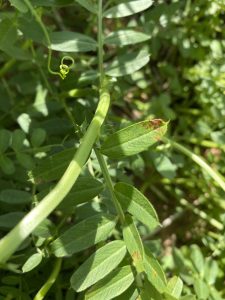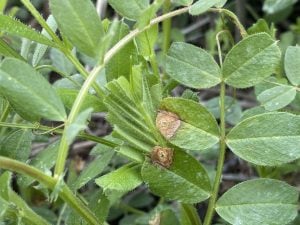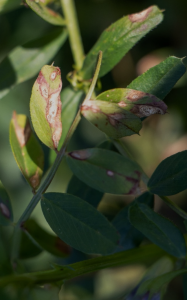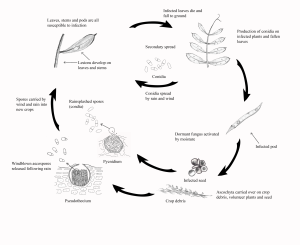The fungal pathogen Ascochyta viciae-villosae causes Ascochyta blight of vetch. Ascochyta blight affects vetch crops early in the season with cooler wet conditions favouring disease development. When temperatures increase and the canopy dries out later in the season, visual symptoms
of Ascochyta blight reduce. This is thought to be due to the infected leaves dropping off and the plant growth increasing, reducing the overall percentage of infected leaves.
What to look for
Ascochyta blight appears as light-grey to white coloured lesions (spots) which are initially light-grey to white but become tan with a dark brown margin. The centres of the lesions become speckled with pycnidia (tiny, dark fruiting bodies). The presence of pycnidia is the best way of identifying Ascochyta blight lesions from those caused by other diseases such as Botrytis grey mould or Stemphylium blight. Ascochyta blight is often mistaken for other physiological conditions, such as a physiological reddening. The cause of physiological reddening is not known.
All above ground parts of vetch plants can be affected by Ascochyta blight including leaves, pods and stems. Symptoms may appear on plants from the seedling to mature stages.

Physiological reddening in vetch which is not associated with disease. (Photo: Joshua Fanning — Agriculture Victoria)
Disease Cycle
Ascochyta blight can carry over from one season to the next either through the seed or infested stubble from previous diseased crops. The pathogen may also infect new crops when spores from infected stubble are carried by the wind from old vetch paddocks. Infection can occur at any
stage of plant growth; however, moisture is essential. Cool, wet weather promotes sporulation, spore dispersal and infection. Secondary spread within crops occurs when spores produced on diseased plants are carried by wind and rain-splash onto adjacent plants. Rainfall late in the season provides ideal conditions for pod infection, which can result in seed infection and discolouration.
Management
Seed Selection
Ascochyta blight can carry over with infected seed which will reduce seedling vigour and potentially cause reinfection. Avoid sowing seed that came from crops that had visible Ascochyta infection on the pods.
Paddock Selection
Ascochyta viciae-villosae carries over from season to season in infected crop residues. Avoid planting vetch crops in the same paddocks or adjacent to previous vetch crops to minimise disease carry over from the previous crops. Allow the previous stubble to break down completely and preferably an additional one-year break before crops vetch is planted in the same paddock.
Variety Selection
Grow vetch varieties with the best resistance ratings. There are a range of varieties available to growers and checking the latest varietal ratings will help you develop an integrated disease management plan to reduce yield losses due to Ascochyta blight.
Fungicides
There are more foliar fungicides becoming registered for use on vetch crops to prevent or reduce disease symptoms. The economics of using these fungicides has not been well established. It is important to check product registrations and withholding periods, especially when the vetch crop is to be consumed by livestock. Fungicides should always be applied according to label directions, ensuring the key points of spray application timing and frequency are observed as well as grazing and harvest withholding periods.





